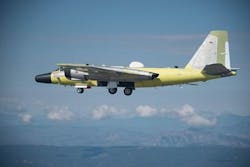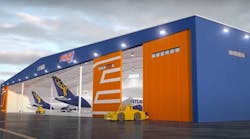DynCorp International team members working in support of the NASA Aircraft Maintenance Operational Support (AMOS) program recently helped make aviation history – aiding in the reconstruction of a WB-57 aircraft 40 years after its last mission. The jet, now identified as N927, had been retired from military service in the summer of 1972 and stored in “The Boneyard” at Davis-Monthan Air Force Base, Ariz. The N927 now holds the record for the longest time an aircraft has been in extended storage before returning to flying status.
Combining Efforts Through Teamwork
The combined efforts of DI and NASA engineers, mechanics and logisticians made this landmark achievement possible. The DI and NASA teams provided more than 50 experts with vast experience in WB-57 operational, maintenance, engineering and logistics for select hands-on contributions last year during varying stages of the regeneration in Colorado.
For example, DI hydraulic specialists hand-fabricated, pressure tested, and installed hundreds of hydraulic lines. Several logistics challenges were overcome as most original parts are no longer in production, and the original manufacturers often are no longer in business. DI team members amassed the required parts, special tools and related products to complete the project and perform almost 1,400 tail-number-specific issues.
“The pride that every member of the DI/NASA team took in rebuilding this aircraft was evident in the final product. It barely resembled the weather-beaten hulk that was pulled from the Arizona desert. It had been transformed into a near-pristine machine, probably in better condition than when it rolled off the production line so many years earlier,” said Tom Parent, DynCorp International WB-57 pilot.
Integrating Custom Modifications
NASA’s WB-57s feature important modifications compared to the originals. Each one, including the N927, has twice as much wingspan and twice the power of the original versions. As a result, NASA WB-57s are capable of operation for extended periods at altitudes well in excess of 60,000 feet. They can fly for approximately 6.5 hours and have a range of approximately 2,500 miles with a useful payload capacity of more than 8,800 pounds.
Contributing to a Growing Fleet
With the N927 joining NASA’s expanding fleet, more options are available to provide the types of payload integration and research platform support for which the aircraft has become noteworthy. Sensors may be mounted at various sites around the aircraft and the Universal Pallet System (UPS) helps accommodate a myriad of payload options.



